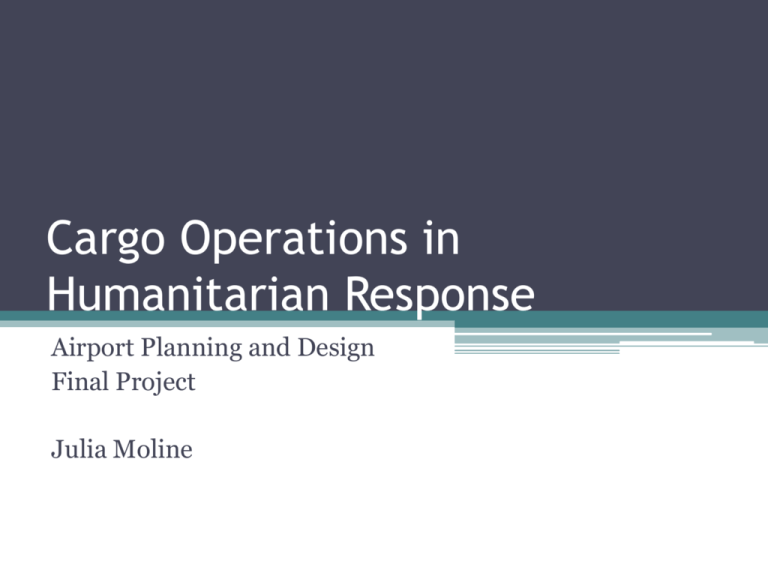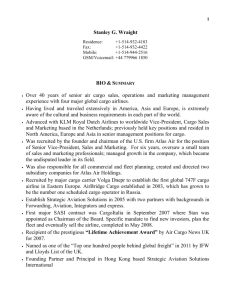ASP Moline_Cargo_Operations_in_Humanitarian_Response
advertisement

Cargo Operations in Humanitarian Response Airport Planning and Design Final Project Julia Moline Agenda • • • • • • Problem Statement Case Study: Typhoon Haiyan in the Philippines Illustration of the problems Proposed approach Airport Selection in the Philippines Conclusions and applications Problem Statement Two major logistical challenges in large-scale humanitarian response: 1. Extremely limited storage capacity and 2. Congestion at airportsdelays in cargo delivery. Typhoon Haiyan in the Philippines Typhoon Haiyan • Struck the Eastern, Western, and Central Visayas regions on November 8th • 12.3 million affected • 700,000 displaced • 5,800 dead and 27,000 injured • Tacloban City, Leyte Province (pop. 200,000) completely devastated Source: businessinsider.com Impacted Areas of the Philippines Logistical Challenges Air and storage capacity Air Congestion • Volume • Time on the ground (TOG) ▫ Limited parking capacity ▫ Limited personnel, equipment ▫ Aircraft type a primary determinant of TOG • Reliability ▫ High percentage of no-shows ▫ Major planning challenges Type Tons/aircraft TOG (min) Tons/hour/space Small 5 62 4.9 Narrow 20 116 10.4 Wide 35 179 11.7 Storage Capacity • Physical limitations (space) • Personnel and equipment ▫ Loading and unloading ▫ Sorting ▫ Tracking • Security considerations ▫ Major consideration!!! ▫ Protection against looting, other security breaches Source: armedforces-int.com Regional Hubs Air hub Operations Selection Criteria • Shipments to remote airport in same region ▫ Relieves congestion • Cargo shuttled between hub and destination at regular times daily ▫ Increases reliability • Scheduling strategy: maximize tons delivered rather than number of flights ▫ Increases efficiency • • • • • Slot availability Physical capacity Personnel and equipment Low risk to natural hazards Accessibility to or collocation with storage hub Cargo hub Operations Selection Criteria • Cargo stored at remote location until needed ▫ Relieves physical requirements at destination ▫ Reduces security considerations • Just-in-time delivery ▫ Cargo delivered only if requesting organization can store or will distribute immediately • Large amounts of flexible storage space • Personnel and equipment • Labeling and tracking capabilities • Proximity and accessibility to air hub Prioritization of Cargo Deliveries • By cargo type: Critically needed items shipped first ▫ Benefit: Enables rapid delivery of most-needed items ▫ Challenge: How are “critical items” determined? • By entity type: Home government first, then others ▫ Benefit: Distributes cargo across entities; aligns with recovery goals of home government ▫ Challenges: How is hierarchy determined? What if the home government is weakened or corrupt? Challenges • • • • • • Coordinating entity and process ownership Buy-in Process control for participating entities “Temporary” warehousing Aircraft availability Personnel and equipment availability Airport Manila Tacloban Cebu Clark Field Subic Bay Subang Code NAIA DZR CEB CRK SBIA SZB Distance from Tacloban 530 mi 0 mi 100 mi 530 mi 530 mi 1,700 mi Runway Description 2 asphalt runways, 1 2000 m and 1 3400 m 1 asphalt runway 2100 m long 1 concrete/asphalt runway, 3300 m long Two 3200 m parallel concrete runways 1 asphalt runway, 2700 m 1 asphalt runway, 3800 m Ample—many empty hangars Ample—formerly naval base and FedEx hub; cargo space is therefore available Storage available at UN HRD Hub Not normally used Limited air traffic during normal operations Fairly busy airport during normal operations Ample Likely ample Some parking, but limited additional spots Ample, particularly with staffing from US Military Likely ample May be some capacity from ongoing cargo operations Cargo Storage Limited, and mostly already in use None Some cargo storage, though apparently full now Arrival/ Departure Capacity One of the busiest airports in Asia; limited additional capacity Extremely congested during Haiyan response Extremely congested during Haiyan response Large aircraft maintenance area could allow for some parking capacity May be some capacity, but tight especially with high volume Parking Capacity Some parking Loading/ Unloading Capacity May be some capacity at Pal Hangar, but limited Extremely limited Current Utilization Some normal traffic continues, and already significant congestion of passenger and cargo traffic C-130’s are allowed in; significant congestion cause massive delays and diverts Significant congestion due to humanitarian flights causing delays and diverts Not typically operational, currently being used by US Military Limited commercial traffic, therefore likely underutilized Normal operations Operators Philippines airport authority Humanitarian community Mactan-Cebu International Airport Authority US Military is using it as its hub for humanitarian relief Subic Bay Metropolitan Authority Malaysia Airports Holdings Equipment Available Some available, not much Loading/unloading equipment limited Loading/unloading equipment limited Some provided by US Military Unknown Some available Extremely limited Hub Selection • Best Choice: Clark Field ▫ Former US Military base with ample operational and storage space ▫ Used by US Military as hub for Haiyan response ▫ Approx. 1.5 hr flight • Additional option: Subang, Malaysia ▫ Near UN emergency warehouse ▫ Used as an international hub in 2005 ▫ Far from Tacloban Operational Diagram Clark Field Air Hub Storage Hub DZR Normal Cargo Flows CEB Emergency Cargo Flows Information Flows Applications • Further research: queuing models for scheduling and inventory levels • DHL “Get Airports Ready for Disaster” Program ▫ Add considerations for partner airports • UN Humanitarian Response Depot Program ▫ Design air capacity into operational strategy for 5 international warehouses




